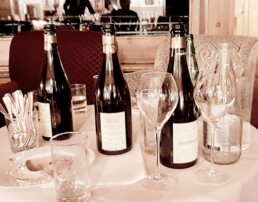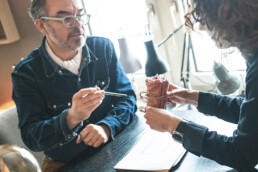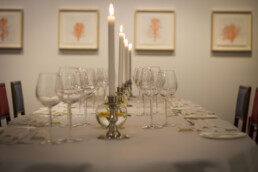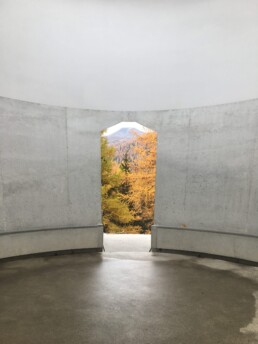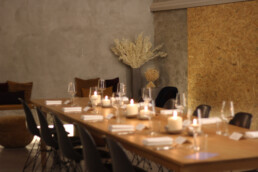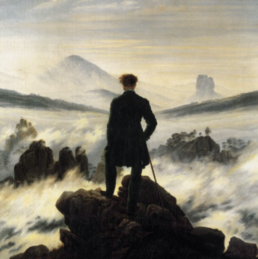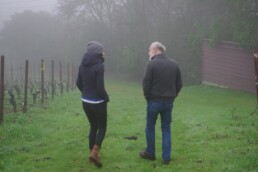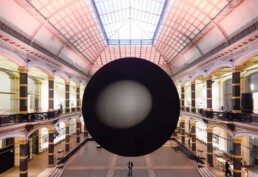Luxury: A Discontinued Model?
It’s remarkable how a few international designers, with their collections presented on the catwalks of Paris, Milan and New York, dictate what will be worn next season. A glance at the Instagram pages of luxury watch and car manufacturers triggers longing and fascination. Luxury objects have long been admired for their precision: for the almost loving care with which, for example, a dress is handmade by Oscar de la Renta and embroidered pearl by pearl. The character of uniqueness resonates with every step in such a gown, just as it does with every ride in a Bugatti or with every look at a Patek Philippe on the wrist. Once experienced, it is a feeling that one does not want to give up. Both the quality of the product, as well as the promise that is transferred to the owner, are addictive. When you own a luxury product, your own status increases - and with good reason.
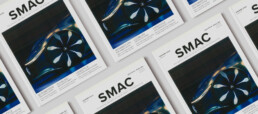
We need to know the source to understand its consequences
The origin of the word luxury comes from Latin, meaning ‘waste’, and was originally used to describe objects not required for everyday use and that were once widely considered useless or unnecessary. Those who could afford to do so purchased them to flaunt their wealth. But how does this scenario play out in an affluent society? We are already surrounded by the unnecessary on a daily basis, while developments such as digitalization are completely changing our consumer behavior. In this context, something as traditional as the luxury industry can quickly lose its magic. Indeed, luxury emerges from the magic of coding, whereas ‘online’ stands for its transparency; luxury is exclusive and excludes, while online is inherently inclusive; the power of luxury stems from its scarcity, yet online creates added value through constant availability. When the status of luxury is suddenly democratized, the entire industry finds itself at a turning point.
The end of senseless consumption
In a time when sustainability and resource conservation are omnipresent, unnecessary consumption (luxury) is almost frowned upon. Can you really afford to sit on one of the nearly 20,000 private flights that land in the Bahamas every year? Does your overcrowded wardrobe need to be regularly updated with the latest couture clothes? And how do we feel about celebrating the excessive consumption of experiences, such as visiting all the European capitals in short trips? Whether you are really enriched by the ‘products’ or rather by the idea of sharing these experiences with your friends is probably questionable. The loud and the unnecessary are losing their charm. But how does status redefine itself in a world without obvious status values?
Knowledge replaces status
In the search for values, materialism has become uninteresting. The understanding of luxury is developing away from its status utility and evolving into connoisseurship. Ultimately, the depth of knowledge about a product defines our level of enjoyment. A perfect example of this are the menus in Michelin Star restaurants that mention the local farmer by name, that enrich our vocabulary with the names of unfamiliar mushroom species, and that even include a nod to the dairy cow who supplied the basic ingredient for dessert. All of these are ways to give (even more) meaning to the product. Suddenly, luxury is no longer defined by the many, but by substance, as the paradigm shifts from the externally visible to the personally valuable.
The age of the connoisseur
This has also become evident in the renewed appreciation for craftsmanship: the interest in handmade shoes, refurbished vintage furniture, and even home-roasted coffee. The end of unnecessary consumption is leading to a new demand for premium quality in the select few goods and products that one allows oneself. This approach goes far beyond clothing, encompassing connoisseurship in areas of intuitive interest, from vintage cars to wines. I don't need a large, flashy collection of Bordeaux if my passion and interest lie in elegant, silky Pinot Noirs. The phase-out model of luxury finds itself in a new level of sophistication and clarity for its own (often immaterial) pleasure and composure. A derivative of this is good conversation with like-minded people, where the emphasis is not on showing off, but on depth.

Share
A conversation with ...
“It is always about atmosphere."
— Yusuf Sert
The Tour of Inspiration Idea
The Tour of Inspiration is a walk combined with curated experiences. This tour is intended to open up one's perspective and, by setting curated impulses, to strengthen strategic business decisions and promote personal development. A physical tour guarantees the best results, however impulses can also be shared throughout a conversation within the Zero Senses Method as a companion. What is valuable is the active exchange that arises during this tour, which includes encounters with artists (broadly defined) and their stories. In the following interview with Yusuf Sert, an interior designer from Zurich, you will gain insights about what such an impulse can look like. Translating the newly gained insights into one's own business life is the artisan work, while Zero Senses offers a methodology.
A Conversation with Yusuf Sert - Interior Atelier, Zurich
Yusuf, tell us, how did this beautiful interior design atelier in the middle of Zurich's old town come into being? I took over this atelier four years ago. After almost a lifetime as an employee, that was when I decided to become an entrepreneur.
Would you mind sharing a bit more about your story? I have to go back a little further here... When I was very young, my father was convinced that the future would be about electronics. He was not completely wrong, because we are talking about the 90s, when we were experiencing the rise of technology companies and computers, like Apple with its Macintosh, etc. I followed the advice of my dad, but even while I was still an electrical engineer, I knew it wasn’t for me. On construction sites, I was fascinated by the plans instead of concentrating on electronics and my master’s degree. Something creative, working in design – that was what I wanted to do. So my next step brought me to lighting design.
How did you get from there to the showroom of a luxury furniture store? The creative side was always deeply rooted within me. Everything that had to do with interior design caught my interest. At the age of 16, I was already building my own lighting fixtures. Everything in my room I’d built myself. So I tried to get into the furniture and interior design business, but they weren’t interested in me and as I wasn’t admitted to the vocational school, I had to find another way to pursue my quest.
What was it like for you to know where you wanted to go, but to feel that the "normal" way was a dead end? I knew I had to get there somehow. I applied to a certain furniture store over and over again, but was rejected again and again due to my lack of experience. One day I discovered an advertisement from one of the furniture stores in Zurich. The unconventional boss – an American – invited me to an interview along with eight other applicants. Miraculously, a short time later I was hired, and that was how I got into the industry.
So you started working in one of the top furniture stores in Zurich without any experience. How did that go? I've never learned so much in my life. There are various things that contribute to how something comes about – I call it fate. In this case, I was alone in the furniture store after three months: everyone had quit. This was certainly the beginning of the end for the store, but for me it was probably the beginning of my most intense phase of learning. The furniture industry is a small one, and suddenly I was in direct contact with all the important actors in it, some of whom became contacts that have remained with me to this day. And in the end, I had the opportunity to follow through the entire liquidation process of the company. I can tell you how this kind of sale has to work. While liquidation is a field of its own, I can still apply this knowledge today. From then on I was firmly anchored in the industry.
What happened then? I used my network to find a new job. From that point on, I never applied for a job again. I gained self-confidence and learned to apply my knowledge in new situations, sometimes without being asked. My new employer was about to create a new lighting concept, and I was of course able to bring in my experience in lighting design. I "worked my way up" relatively quickly, and stayed with this shop for 13 years.
In the midst of all this success, how did you get the urge to do something of your own? I was living a double life. Whenever I went to furniture fairs, I shopped for the store, but also for myself in my mind. I kept a mental file of the pieces I would have liked to buy for myself, albeit still at the imaginary level. I knew that at some point in my life I would have my own shop. I always carried this idea in me.
Now here we are, sitting in your shop. What was the path that led you from your dream job back then to becoming an entrepreneur? The furniture business is a small world – I knew where I wanted to go and where I didn't want to go. For me, still today, it’s very important to know what you don’t want. And I’d peaked within the industry. There was nothing new that interested me anymore. I’d reached a turning point.
One day, the owner of the shop that we’re sitting in today called me and asked if we could meet. He came right out and asked me if I want to buy his shop, and we wrote the contract straight away on a napkin. There were of course other interested parties, but he seemed to have the best connection with me. He was about to retire, and I offered him the opportunity to keep a desk in the shop as long as he wanted.
How did it feel to suddenly have your own shop? I was a new person. I’m an entrepreneur, not a manager.
What is the difference in thinking like an entrepreneur and like a manager? I once said to a manager, "You always make me feel like I'm doing everything wrong." Managers have to be guided by facts. Everything needs a report, every decision has to be justified, preferably with market analyses, while feelings are completely irrelevant in the decision making process. That's not how I work.
An entrepreneur is not only concerned with the best margin. I can't just buy the top selling stock. I have to pick things that suit me. What fits my DNA? What doesn’t? Are there things that make me wince a bit when I order them? This is the exciting part. We have to show the customer what they might want. This can mean going a bit outside the DNA in order to be one step ahead, but always keeping the spirit of the times in mind. That's our job.
And how do you "manage" today? Everything goes a hundred times faster. For example, when I buy something new, I’m never sure if the product will work. I can make spontaneous decisions; I might decide while I’m unpacking it whether to keep it or use it differently than originally planned. My work is all about split-second decisions based on gut feelings – not on major market analyses.
Is using this gut feeling something that can be learned? Yes, you have to learn to choose from your gut and decide from your head. It’s a combination.
Where do you get your inspiration from? It's the combination that matters, that's very important. German, Italian, French and English magazines have always been a source of inspiration for me. But not only that: I always ask my friends to bring home magazines when they go on holiday. Each country has a different approach or mentality. You can even see the difference between the French-speaking part of Switzerland and how we do things here in Zurich. And I put a lot of thought into the issue of beauty. What does aesthetics mean, what’s behind a customer’s "I like it" or "I don't like it"? Also, I’m a bit of fan of Oliver Jan and AD Germany.
Is there a person who has particularly shaped or inspired you? There are many. In general, I've noticed the greater of an expert someone is, the less likely they will say, "this isn’t possible". Confident “amateurs” are the ones who judge immediately. But true experts allow for a diversity of approaches. They’re open to other perspectives and give them a chance. This is how good concepts are created. I think that almost nothing is ugly. Our task is to create the right context.
Just to illustrate that, here’s an example: In our industry, 85% find minimalist tables with thin legs aesthetically appealing, but in America, only 1% of people would say that’s beautiful. The world is so different, and our design world is so small. We have to be open and listen to what the customer wants. In Mexico, our atelier would look like the entrance to a prison, because there the driving aesthetic is opulence, not simplicity.
Does your inspiration fit into any geographical categories? The Italians were the first to conquer the design market, but the "new" Scandinavians offer incredible spectacular works. They're a bit ruthless, but they do strike a chord. Otherwise I look to Switzerland for precise design, to England for anything with a Heritage resonance and to France for a Bohemian touch.
Where is the design market heading? Towards a warm minimalism.
Have you ever regretted any step you made? My father was right, all my colleagues from back then have made careers in technology companies. But I have to tell you, I've never felt better: I feel young and completely in my element.
About
Yusuf Sert, interior and lighting designer, has his studio on Oberdorfstrasse in Zurich. He is known for the unique atmospheres that he creates for his private and corporate clients, using his own designs and those of prominent manufacturers.
Share
Circle of Inspiration: A Dinner in the Gallery
About the Circle of Inspiration
The Circle of Inspiration, a salon-like event that focuses on good conversations within inspiring venues, took place in February in St.Moritz. A unique visual and culinary tour curated by Zero Senses, it led guests through the three floors of the Hauser & Wirth Gallery and featured inspiring thoughts by the director of the gallery, Stefano Rabolli Pansera, about the “art of creating context”.
A review written by Tanja Schug
How to Curate a Good Conversation?
Let’s be honest: one rarely gets inspired at conferences or even at regular business meetings: these occasions are often mere repetitions of what is already known. I have mostly found inspiration through serendipitous one-on-one conversations with people from outside my professional field. Such meaningful encounters bring new insights. However, good conversations seem to be a rarity nowadays, and when we do chance upon one, it is most likely outside of crowded conference halls.
Is it possible to create an event that is designed to make meaningful conversations happen? I was intrigued by the thought of translating my inspiring moments into a format in which I can share this experience with others. The Circle of Inspiration is a private event, where an intimate group of carefully chosen guests from different fields dive into a given topic and open each other’s perceptions by sharing their perspectives. The Circle always takes place in a unique and inspiring atmosphere that is relevant to the theme of the evening.
The aim of the Circle of Inspiration is to expand existing thought patterns and open up new mind space. Sounds abstract? Ultimately, it is about having a good conversation in an environment that fosters meaningful exchanges.
The Art of Creating Context
The Hauser & Wirth Gallery is one of the world’s best known and highly regarded art galleries. Its director, Stefano Rabolli Pansera, an architect by profession, presented the gallery’s current Charles Gaines exhibition to the guests. As an architect, his strength is certainly not only that he understands the fundamental idea of creation, but also has the skill of creating an impactful and fascinating context around any (art) piece he speaks about. Stefano shared his insights about the much admired (for some, overrated) and yet magical art world:
“The art world is an extraordinary ecosystem, where all actors must play an active role: artists, collectors, galleries, institutions, curators, journalists, and teachers. Art galleries can be interpreted as agents to trigger, construct, enhance and nurture contexts for their artists as well as for their collectors. Art galleries contribute to the creation of a cultural context for artists, revealing the wider cultural horizon where their work is conceived and produced. Art galleries construct an audience of possible collectors enriching the market (the commercial context) for its artists.”
“The art world is an extraordinary ecosystem, where all actors must play an active role: artists, collectors, galleries, institutions, curators, journalists, and teachers. Art galleries can be interpreted as agents to trigger, construct, enhance and nurture contexts for their artists as well as for their collectors. Art galleries contribute to the creation of a cultural context for artists, revealing the wider cultural horizon where their work is conceived and produced. Art galleries construct an audience of possible collectors enriching the market (the commercial context) for its artists.”
— Stefano Rabolli Pansera
Bringing back the Magic
For me, the art of creating a context is connected with the need to add a touch of magic to a grey, dull and crowded world. Due to constant availability and connectivity, people have unlearned how to be “enchanted”. We no longer know what it means to wait for something. From one-click buttons to social media and messages, everything is instant. But where is the magic? What triggers our curiosity? And what draws us under its spell? When you ask yourself what enchanted you last time, you will probably have to go back to your childhood. Maybe you remember how your mother or father once told you a fairytale. Most of us remember these simple but magical moments of excitement and suspense when listening to a fairytale which promised a happy end. These are the moments that we need to re-create. I am convinced that if we create magical moments in everything we do, we bring back attraction, curiosity, imagination, and beauty to everyday situations, including business. The art world is a wonderful example of this.
Connecting two Worlds
Zero Senses is deeply connected with arts, as the name of the company, which refers to the post-war ZERO art movement, already expresses. Zero Senses also resonates with the process of artistic creation in the way it helps its clients find inspiration.
The fact that I curate individual Tours of Inspiration for my clients is ultimately a transposition of what an art curator does for galleries, making the Hauser & Wirth Gallery an ideal venue that also embodies the meaning of curated inspiration.
Curating a physical and mental mind space for serendipity and good conversations is what the Circle of Inspiration aims to do. Thank you, Stefano Rabolli Pansera for having given us great insights into the art world!
Share
The Era Of Artists
Profession: Job Title
Imagine you are invited to a dinner party with lots of people you have never met before. As you enter the room, the host introduces you to a group of strangers. It is a moment when most of us hold our breaths: what will he say? How will he introduce me? Usually we are introduced with our job title and the name of the company we work for. But what does that really say about us?
Our social status is largely connected to our profession. If Angela Merkel loses the position of the most powerful woman in Germany, what will remain? We can ask the same question when the CEO of a major bank resigns. Again, what remains from the prestige of the position? One thing is certain: the number of invitations that people receive will drastically fall as soon as they leave their role and suddenly become “less important” in the eyes of society.
Defining who you are based on values, talents and passion is certainly not an easy task, yet it is the most sustainable of all ways: no one can ever take such a “title”, which purely expresses who you are, away from you. Letting go of the superficial shell of a job title requires courage and confidence: by leaving, it may seem that we cut off a part of our identity. Yet in reality, true identity cannot be determined by social status. Its source is inside us.
There are two ways of gaining recognition: either by following a predetermined path, shared by others; or by introducing and applying a new discipline. For example: a marathon runner who aims for a new course record will be appreciated only as long as he or she holds the record, but those who introduce a completely new discipline might set a lasting impression.
A Character is Born
The word character originates from the ancient Greek expression kharakter (= engraving), which means “engraved mark”. The initial meaning gave rise to the definition “distinguishing qualities”. When it comes to people, the ones with character are fascinating even in their imperfections. Their beliefs and distinct features - what I refer to as “edges” - shape their lives in an authentic way. The key to achieving this state of mind is a conscious self-awareness that helps manifest one’s characteristics.
Developing character is not something that can be faked. Authenticity requires continuous and hard work: it takes a lot of time to develop the “edges”. Pablo Picasso started his painting career with realistic portraits at the age of 15. Over the years, however, he developed his own style, gradually opening a new dimension of art (Cubism) in his early 30s. On our character journey, self-realization becomes the prime objective, regardless of expectations (like deriving one’s identity from a job title). The yes’es and no’s of an authentic life stem from clarity; which fuels the filtering of opportunities, decisions, people, concepts, and ideas. Therefore, clarity gives focus. Furthermore, a character does not show arrogance - it would be a contradiction, a person simply is who he or she is.
Beyond Competition
Have you ever asked yourself why so many friends (or even yourself) want to run a marathon at least once? If we are very honest, of course, a sprinkle of competitiveness always accompanies our decision to sign up for a race. It would only be fair if we asked ourselves: “Why do I need to show that I am ‘better’ than others?” The answer is probably linked to our need to belong and to find a role in a certain context, expressed through a status in the top ranks.
People with true character do not care about the racetracks of societal expectations, they create their own context instead - even if it is considered irrelevant or ridiculous by society. Today most people who are regarded as “successful” have no character, but are merely smart enough to play well within the system. However, since titles no longer bring satisfaction, my conviction is that we are entering an era in which developing character will be as “normal” as studying to be a lawyer or financier is today. The quest for meaning in a world where everything is instantly accessible is increasingly gaining importance. I see a craving for meaning beyond knowledge and for true differentiation based on quality. A job title is not enough anymore.
Substantive change never originates from the masses: overconsumption, instant access to goods and services globally, and the banality of infinite freedom creates a sense of emptiness in the soul, as one realizes that what appeared to be part of one’s identity was just a piece of rented-out and meaningless decoration. As the shell starts to crumble, we realize that the true context lies within ourselves. The era of artists arises.
How to Become a Character?
It does not matter whether we want to learn a new language, become more athletic, or run a successful business: strict focus and consequently developing a routine is essential for success. As an experienced yoga teacher once told me: awareness, development, proficiency and mastery - this is the due course of every discipline.
Zero Senses helps you become aware of your values, develop a conscious understanding of your vision and wants, and embrace all this in confident decision making. As we consistently practice this course, mastery will follow.
Like a catalyst, we condense your essence. What remains is your characteristics expressed in words and a clear picture. A conscious awareness of your character guarantees more clarity expressed through independent decisions, as well as for being seen for who you are.
image source: https://www.wikiart.org/en/pablo-picasso
Share
Circle of Inspiration: A Perfect Match
It was something different - intimate and refined in a very special location”
— Quote from a guest
How is the Circle different from a normal dinner invitation?
A selected group of leaders and artists from various fields were invited to enjoy the salon-like atmosphere of a surprising location: the private atelier of a young, yet well-known Zurich chef, where the guests experienced an inspiring dinner with a special “sensory highlight”.
The Circle of Inspiration takes place in a private environment that I carefully curate for that night. Curation means that we create a unique experience that sharpens sensory awareness by consciously choosing even the minutest detail. On the last occasion, we took the guests on a carefully-prepared taste journey: my great partners in culinary experiences, Patrick Schindler and Luca Tribò helped me with the curation, from perfectly harmonizing the menu with the wine selection to creating the general atmosphere.
“It was a journey to paradise - to your paradise of spirituality and intellectual power”
— Quote from a guest
However, curation extends beyond refining the details of the dinner. Invitations to the Circle are carefully considered: personal connections can only flourish between people who match in personal qualities and interests. Guests are chosen carefully, based on their background and personality (beyond job titles), creating a fertile ground for fruitful discussions and meaningful relationships. Therefore, an invitation means that guests can trust that they will have an enriching experience.
The Circle of Inspiration is a framework in which inspiring conversations can flourish and the members can receive impulses instantly. On the occasion of the one-year anniversary of Zero Senses, I illustrated with a recent example how my approach of curated inspiration works in practice. However, I only provide the framework. The real impulses are given by everyone else who is part of the Circle.
“It should become natural: to stimulate our senses for changing the world”
— Quote from a guest
Essentially, the idea behind the format is rooted in the everlasting need to find the right source of inspiration: I create an atmosphere where inspiration can flow in abundance. The Circle is a condensed version of what I offer in the Zero Senses Retreat ‘Cultivating Presence’, where only a hand full of natural leaders will come together from various fields to receive inspiring impulses.
Share
Curating Inspiration for Natural Leaders
Abstract: Natural leaders are always considered to be models, sources of inspiration and confident decision makers. However, these roles can become burdensome. How can you inspire someone who represents a spark of inspiration for others? Zero Senses curates inspiration for natural leaders, providing an unbiased mirror and personalized impulses to break through the narrow perspective of their comfort zone.
“All authentic art is conceived at a sacred moment and nourished in a blessed hour; an inner impulse creates it, often without the artist being aware of it”
Who Inspires the Inspirer?
Natural leaders are charismatic individuals with an innate talent for guiding and inspiring others. Yet, they face the same struggles as everyone else, feeling the paralysis of great life decisions and the immense fear of missing out on a large deal. The natural skill of leadership comes at a price, which is meeting expectations - to always make the right decisions, never lose out on an opportunity, stand undaunted in front of adversities, and remain a constant source of inspiration.
Natural leaders are in a constant delivery mode to satisfy the people around them: on the surface they seem to be in charge, yet even the life of a successful CEO is dictated by the agenda. When facing the void, like unexpected freedom, they feel lost. Entangled in the quagmire of daily affairs, natural leaders rarely seek inspiration; which, if it happens, only comes from within their current field of awareness. The sweet spot is to open up perception and find inspiration from beyond their field, enlarging their horizon.
Artists of romanticism like Kaspar David Friedrich painted almost perfectly realistic landscapes, portraits and historical scenes, adding only a touch of drama by deliberately emphasizing a certain aspect in the composition. They made this emphasis through, for instance, an abundant application of vivid color or an exaggerated depiction of emotions that almost slides into sentimentality. The result is an image that is grounded in reality, yet bestows upon us a sensation of magic that we struggle to describe. In the business context, Zero Senses adds this sprinkling of drama by curating an “exhibition” of inspiring impulses to open up perception and ultimately inspire the inspirer.
Impulses: Sparkles of Awareness
There is one element that is always behind inspiration: the impulse.
Through impulses, Zero Senses opens up perception. The result is inspiration, which enlarges your vision of reality and offers a higher level of awareness. The ultimate reference point is always reality. However, awareness of values, motivations, and drivers is the foundation of conscious action in business life.
Anything that inspires you can be an impulse. It can be a sensory stimulus (food, wine, opera, etc.), an experience (physical or intellectual, such as exhibitions, speeches, new technologies, etc. ), or an encounter with an inspiring individual. However, to really touch your awareness, impulses have to be individual. An impulse is a “glimpse of fire” that triggers an emotional or intellectual response, activating past experiences, personal values, beliefs, and motivations.
You can only receive new impulses that you find relevant or familiar. When you cannot relate to an impulse, it simply takes too much effort to connect with it - therefore, you subconsciously ignore it. However, if you are genuinely interested in an area, awareness will arise more naturally. That is why Zero Senses sets impulses that are individual and very personalized to your needs, including those of your business.
The Phases of Curating Impulses
Zero Senses offers a journey of 0+3 Phases.
Like a curator who builds a context by carefully selecting art pieces for an exhibition, we pick the right impulses to trigger your awareness. As a curator needs to understand artists, we need to understand you.
The journey therefore starts with Phase 0 (Zero), which is an in-depth conversation. We guide your thoughts with the “Zero Senses Matrix”, based on Tanja’s 15 years of experience working with and in large companies. We identify fields that represent personal interests (i.e. inner drivers), external factors like objective megatrends, including environmental matters (i.e. sustainability and new technologies) and societal developments (i.e. changes in societal behavior, preferences of the next generation, or the understanding of luxury). We also take current projects into account. The outcome is your essence, which sets the framework for the following phases.
After we identify your needs, we will not sit in a classroom browsing PowerPoint slides. Mere knowledge is not enough. Instead, we go for a walk. Phase 1 (Impulse) is a session of curated impulses, which can include a stimulation of the senses, encounters with creators, and personal trend experiences (new technologies, social behaviors, environmental changes). In Phase 2 (Translation) we condense the essence and connect it to your business (vision, goals, plan of action). In Phase 3 (Companionship), you will apply the essence on a concrete example and learn to use it consciously. During the journey, we constantly build and maintain a bridge between personal experience and your business life.
Zero Senses provides an independent, detached, free, and inquisitive mirror; besides an extensive network and the right mix of personalized impulses to break through conditioned and narrow perspectives. Ultimately, the journey of inspiration leads natural leaders to become aware of their creation.
Share
Companion of Self-Reflection
“When we are alienated from our gut feelings, we have no longer a sense of reality or a sense of truth. The good news is: human beings can regain connection to themselves (…). All we have to do – not an easy task, but is certainly available to us – is to get back to our true nature.”
Dr. Gabor Maté - Canadian Physician
A Reset to Stillness
Alienation from our authentic self means losing sight of what truly matters to us, because we are distracted by the siren song of false drivers. The noisy, hyperactive superficiality of consumerism provides plentiful substitutes of the lost meaning: we chase job titles, awards, possessions, embellishments of material success, and social recognition. As the above-quoted Dr. Maté said in the same presentation: “Much of the economy is based on a loss of meaning in our culture.”
The loss of trust in intuition is the direct result of our alienation. After the Second World War, artists of the ZERO movement abandoned the very concept of art to find a pure expression of truth. Similarly, to find your true self, you need to let go of the substitutes that fill your inner void: the embellishments of visibility, the internalized command to fulfil societal expectations, and the general misuse of the concept of “career” as a source of identity. A complete reset to stillness and emptiness is essential to perceive who we are in the first place.
In Vino Veritas
Tanja Schug, the founder of Zero Senses and a former brand consultant, is deeply passionate about wine. In the past, she contemplated different ways of pursuing her hobby, from becoming a winemaker to running a vineyard in California. Yet, none of the options felt right, as if wine were only a transmitter of a deeper meaning. When we taste a sip of wine, we naturally struggle to distinguish the components, the mental images behind the rich cacophony of flavour and smell. As Gordon M. Shepherd wrote in his book, Neuroenology: How the Brain Creates the Taste of Wine:
“(…) Although one consciously perceives a smell, a smell that has properties of an image, that image is not conscious. (…) We are very good at recognizing complex patterns, such as someone’s face, but lack the vocabulary to describe them. This is exactly the challenge in describing the qualities of a wine aroma.”
Wine tasting is a conscious effort to identify layers of sensation, like traces of pineapple or blueberry. Through conscious discernment, you create a bridge between past experience and the sensory perception of the moment. Hence, wine becomes a vehicle to instil your existing knowledge into a new context. Once Tanja came to this realization, she decided to apply the same pattern in her life, extending the notion to new domains.
“Awareness of my feelings and the ability to connect them with my experience provide me with an unshakeable trust in myself”, she affirms. Self-confidence and independence from outside influences (i.e., statistics, analysis, and confirmation) stem from the cornerstone of self-trust. Tanja became a change catalyst and companion of natural leaders in realizing their personal strengths and reactivating their intuition through conscious intelligence. The latter emerges from the balanced connection of rationality and emotions through the sharpening of sensory awareness.
Agreeing to the Journey
Returning to ourselves is a tedious journey. The undertaking might seem daunting because of its apparent loneliness and defiance of societal expectations. As the most fundamentally intimate and important things in life, we are essentially alone with the responsibility and effort bestowed upon us by our commitment.
In Tanja’s view, the first step is agreeing to the departure: “The decision to sign up for the journey is harder than it appears. We are instinctively afraid of change. However, it is better to decide consciously that we are indeed at a point where we need change. Otherwise, life will force us into change.”
Leaving the concern of everyday business and throwing out the unnecessary garments of superficial trivialities takes courageous determination. Deliberately locking out the noise and at least temporarily leaving our ordinary context is essential to start seeing beyond the surface of everyday life. Yet we do not have to be lonely on this journey.
It is no coincidence that even mythological figures were led by trusted guides through their journeys. At the beginning of his Divine Comedy, the medieval Italian poet Dante Alighieri finds himself in a dark forest, completely lost and overtaken by fear. Yet, he soon found a guide: Virgil, the Latin poet, leads him through the steps of a mystical journey from hell to paradise. As he told Dante: “I therefore think and judge it best for thee / to follow me; and I shall be thy guide.”
Most of us are too busy running on our treadmills to realize the true magnitude of our self-alienation, let alone to consciously look for sources of inspiration or an adept guide to lead us back to ourselves. As our ancestors showed us, we never walked alone on new or difficult paths.
A Mirroring Companion
Reaching a state of clarity is a prerequisite of change. Zero Senses is a detached and neutral mirror, purely reflecting your deepest values, drivers, and aspirations, without adding or taking away anything. Without guidance, you might follow the path you already know. Without safety, fear of judgment might deter you. Zero Senses not only creates a safe atmosphere of acceptance to awaken your awareness, but also curates impulses to widen your perception. We accompany you on a journey of transformation.
Tasting wine taught Tanja that understanding emerges both from knowledge and experience. The sharpening of sensory awareness and the reactivation of intuition lead to more clarity, which in turn becomes the foundation of personal independence and inner stability.
However, there is no uniform way to cultivate awareness. Zero Senses curates the impulses through choosing sensory stimuli that match the personal characteristics of natural leaders. During a profiling phase, we identify the key topics of interest and relevance, ranging from visuality (e.g., art and nature) to human impulses (e.g., meaningful discussions with inspiring people).
Ultimately, we distill your essence: as your strengths manifest themselves, you can start translating and using them intuitively within every moment, discussion and situation. As your conscious intelligence improves, you can slowly unravel and change the underlying patterns of your life.
Share
ZERO Is The Light
Abstract
ZERO announces a new beginning. In my belief, this new start gets created by oneself. In this world we're living in, we are distracted by outside impulses: our need for belonging, our wish to be seen, our hope to be successful. But where do we actually want to belong? By whom do we really want to be seen? And what does success truly mean for us? ZERO is the starting point for a new way of thinking, of finding what truly matters. Because it starts with you, your essence, your being. ZERO is you. An unmanifest silent space inside of you filled with pure possibilities. Therefore ZERO is not judging, it is positive, immensely optimistic. Its fuel is curiosity, the curiosity to create.
What inspired me to found Zero Senses is that you cannot find purity on the surface of anything. You have to see beyond the obvious to find ZERO. The art movement I am referring to experimented with new forms of expression after the Second World War. ZERO SENSES translates this into business reality, offers a path to find your ZERO, and empowers you to use it as a basis on which to live your true self.
“Zero means silence, Zero is the new beginning, Zero is round, Zero is the moon and the sun.
—Mack, Piene, Uecker, 1963
The Art of Letting Go
In the aftermath of the Second World War, a small group of German artists aimed to break away from the reigning post-war pessimism and artistic conventions. In the early 1960s, the founders of the ZERO art movement (Heinz Mack, Otto Piene, and Günther Uecker) decided to return to the origin of creation, to ZERO. The artists let go of a damaged universe with optimistic resignation. It wasn’t the fake hurrah-optimism of today’s performance-society (Leistungsgesellschaft): they had to give a new meaning to their lives embracing nothingness because the very meaning of human existence had seemingly vanished.
Obtaining a clean slate of purity meant forgetting the past, thus freeing the future from its burden. ZERO artists jettisoned dusty dogmas and the stifling conditions of expectations. For others, emptiness might have been fearfully paralyzing. For them, it meant unprecedented depth and endless possibilities. First, they questioned the very basis of art by emptying the canvas. Then they questioned the canvas too. When almost nothing remained, they stripped down art to its essence: light, space, materials, and shapes. Instead of brushes, the artists took nails or alternators, scribbled on metal wires, explored the infinite meanings of a single color, or flapped aluminium blades in the light.
ZERO artists distinguished their style by focusing their creative energy in a single means of expression. Günther Uecker introduced a new layer of vision by using a hammer and nails instead of paint and brush, opening up an unusual entry point for the observer. Otto Piene expressed depth with lights and fire. Creators who joined the movement later further enlarged its repertoire. Lucio Fontana directly broke through the canvas by cutting or hammering holes in it, shattering the seemingly suffocating two-dimensionality. Yves Klein showed that even a single color (monochrome), his famous ultramarine blue, condensed endless layers of depth.
„I make a hole in the canvas in order to leave behind the old pictorial formulae, the painting and the traditional view of art and I escape symbolically, but also materially, from the prison of the flat surface.“
— Lucio Fontana
Touchpoint of ZERO and Senses
“Before you can express yourself, you need to assert yourself”, said Günther Uecker. Knowing who you are and what truly matters to you comes first. Challenging expectations and societal conventions only follows. ZERO artists courageously abandoned dogma and expectations without compromise in order to create space for the purest, deepest, and most authentic form of art: expressing the true self.
Modern life has inundated us with constant noise, endless opportunities, and lingering uncertainty. Stress stems from our own expectations, fuelled by the exterior: we relentlessly crave recognition, title, money, and status. We nurture an ardent desire to belong, to be visible, and to be successful. However, we rarely question the very mindset of constant performance. Where do we actually want to belong? Who shall see us? What does success mean at all?
Tanja Schug, the founder of Zero Senses felt that we need a similarly profound and purifying change in business life. Inspired by the art of letting go, she helps natural leaders reach their personal point ZERO in a safe environment. She has understood that curated stimuli of the senses (like seeing, smelling, and tasting) sharpens the awareness of feelings. Connecting ZERO with Senses, Tanja invites you to embark on the journey of discovering, embracing, and gradually realizing your true self through cultivated intuition and ultimately more clarity in any decision.
Following the Path of ZERO Artists
The emptiness of point ZERO is the silence before the creation of the universe. The first step is to leave the crowd and courageously retreat from the minutiae of daily life. Like Günther Uecker’s hammer that struck nails through the canvas, one by one, the impulses of Zero Senses gradually increase your sensory awareness.While Lucio Fontana defied the two-dimensionality of the flat canvas by breaking through it, Zero Senses helps you gently transcend the surface of your everyday routine to finally see your life as it is, and make decisions with the clarity of a higher context.
The resulting balance between your rational and creative sides will restore your trust in your own intuition. Clarity is the foundation of a profound transformation. The fog of everyday routine will slowly dissipate, revealing the old patterns and habits which are invisibly intertwined with all aspects of your life. However, cultivating clarity requires tremendous effort and commitment. As Otto Piene saw it, “darkness has the potential to become light”. Just like light and shadow, struggle and joy belong together, stemming from and feeding on each other.
The journey starts with you, your essence, your being. You will not only understand, you will start to see. Similarly to ZERO artists, by connecting previously unforeseen dots, you will be able to transmit your true self into your reality.
ZERO is your beginning.
Let there be light!
Share
